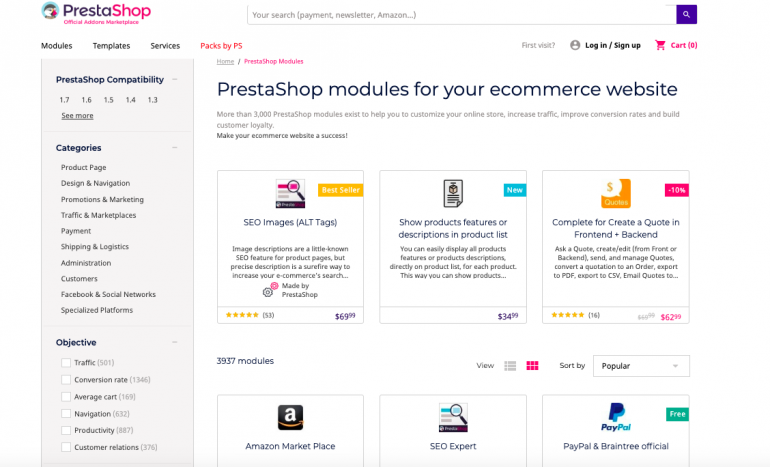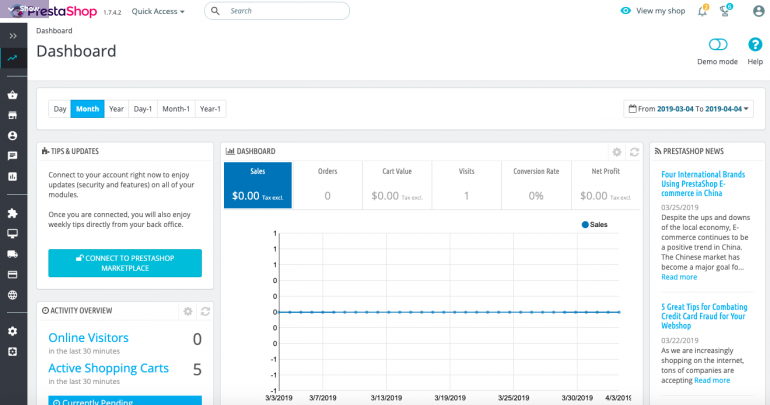PrestaShop Review: Pricing, User Reviews, Alternatives
Explore PrestaShop features, pricing, customer reviews and alternatives of this open-source e-commerce platform.
Many, or all, of the products featured on this page are from our advertising partners who compensate us when you take certain actions on our website or click to take an action on their website. However, this does not influence our evaluations. Our opinions are our own. Here is a list of our partners and here's how we make money.
Table of Contents
Table of Contents
With a variety of e-commerce platforms on the market, all at different price points, you may be wondering if there are any free options. That’s where open-source platforms, like PrestaShop, come in. Unlike many other e-commerce solutions, open-source platforms are free to download and allow you to modify the code of the software to fit your specific needs.
If you’re interested in an open-source platform, PrestaShop is definitely one of the best available options. Keep in mind, however, that there are added costs beyond the software itself. Here's what you need to know to decide whether PrestaShop is right for your business.
» MORE: Best POS systems
advertisement

Shopify Ecommerce
$29
Basic Plan. Grow & Advanced Plans Available.
on Shopify's website
Features
Although PrestaShop is an open-source solution, the platform includes a significant amount of features out-of-the-box. According to its website, PrestaShop has over 600 features, fulfilling your full range of e-commerce business needs — store management to shipping to marketing and more.
Store creation
PrestaShop allows you to create your store’s website and customize it to your business. You can either use and customize the default template or buy and download others from PrestaShop Addons, its official add-on marketplace.
With your PrestaShop store, you can organize your products, configure internal search, adjust the navigation and dictate your checkout process, including one-page checkout. In addition, you can optimize your store for international business. PrestaShop includes translation for over 25 different languages and allows you to use a multi-language product sheet to adapt to different markets. You can also set the currencies you accept and automate the exchange rate movements.
Payment processing
To accept online payments with PrestaShop, you have a variety of options. You can work with one of the PrestaShop Partners (free or paid), which includes payment processors like PayPal, Braintree, Amazon Pay, WorldPay, Authorize.Net and more. You also have the option to pay for and download one of the other 250+ payment add-ons from the PrestaShop marketplace.
Product and customer management
With the PrestaShop e-commerce platform, you can list an unlimited number of products on your site. You can give features and values to your products, create packs, sell customizable goods and sell digital products. You can also create both product categories and subcategories, track your inventory and get a dashboard overview of your manufacturers and suppliers.
For your customers, you can allow them to create an account and track their orders. Through your PrestaShop interface, you can create a customer information database, as well as run customer-service activities.
Order management and shipping
You can create and edit orders from your PrestaShop admin, customize a workflow for orders and returns, print shipping slips and automate email templates for different order statuses. PrestaShop also allows you to configure shipping with your chosen carrier, choose delivery zones, determine the pricing for different shipping methods and calculate taxes based on location.
Marketing and reporting
PrestaShop includes integrated marketing and reporting capabilities. You can create special offers, highlight your products and increase engagement through abandoned cart, recently viewed and back-in-stock product emails.
PrestaShop lets you manage your store’s SEO, connect to social media pages and run digital advertising on your site. The reporting functionality allows you to track marketing, sales, customer and product performance — all while providing an overview of your main data.
Add-ons
You can only download and buy add-ons from the PrestaShop marketplace — which offers over 6,000 modules, themes and services — ranging from site navigation tools to social media integrations to shipping services.
Support
As an open-source solution, dedicated support is not included with PrestaShop, however, it does offer different support plans at additional costs.
You also have access to useful resources like the PrestaShop forum, community, documentation, FAQs, as well as YouTube tutorials.
Pricing
After going through the full range of features that PrestaShop offers, you may find yourself asking, “Is PrestaShop really free?” This is a valid question, and the answer, unfortunately, requires more than a simple “yes” or “no.”
PrestaShop’s e-commerce platform offering is open source, so yes, it’s free to download. However, although the actual open-source software is free to download, this doesn’t mean that it will be totally free to run your e-commerce business through this platform.
If you use PrestaShop, you’ll have to find your own web hosting, which comes at a cost. Using PrestaShop’s hosting partner, for example, will cost you anywhere from $8 per month to $14 per month, depending on which plan you choose.
Other hosting providers may have different rates. Additionally, there will be the cost for payment processing, which will vary depending on the processor. Stripe, as an example, charges 2.9% plus 30 cents per transaction. Some of the payment add-ons are free to download with PrestaShop, like PayPal, for example. But others, like Square, require you to pay ($169.99) to download the module itself.
Additionally, if you want to extend the functionality of your store to more than what is included in PrestaShop, you’ll have to pay for themes and modules from the marketplace to allow you to do that.
The more customization you want, the more you’ll need to work with a developer to help you build your site. This is an added cost (and potentially a big one) people often forget about when it comes to open source e-commerce platforms. Unless you have technical knowledge, platforms like PrestaShop typically require help from a developer to set up and sometimes manage, your store.

Source: PrestaShop
Pros
Features
There’s no doubt that with 600+ features, PrestaShop gives you a lot to work with when building and running your e-commerce website. From unlimited products to one-page checkout to abandoned-cart emails, you certainly can’t say you’re missing out if you use PrestaShop. Plus, as an open-source platform, you have an impressive amount of capabilities from the start, especially considering the software is free to download.
Additionally, if there is an ability you’re missing when you use PrestaShop open source, you can explore the 6,000 add-ons in its marketplace to increase your functionality. Also, if you choose to capitalize on the flexibility of open source, you can truly customize the software to your business, in ways you can’t with a typical e-commerce platform.
Usability
Even though PrestaShop was first and foremost an open-source platform, by all accounts it seems to be user-friendly and pretty simple to use (as you can see from its free demo). The platform has incredible functionality, and yet, the dashboard is still clean and intuitive.
Although you may require some developer assistance if you’re using open source, PrestaShop certainly appeals to beginner and advanced users alike, especially when compared to some other open-source software like Magento.

Source: PrestaShop
International reach
Probably one of the most unique qualities about PrestaShop is the international reach its platform offers. Based in Europe, PrestaShop has ensured that its users’ businesses can function across the continent — and beyond.
In fact, out of its almost 250,000 live sites, over 30% of those sites are U.S. based. Since you can present your store in several different languages and currencies, as well as adjust your checkout for varying taxes and shipping, PrestaShop is equipped to facilitate businesses all over the world.
Customer reviews
PrestaShop product reviews on the internet are generally positive. Customers say that the platform is flexible, handles many different capabilities and can be a good fit for users of varying experience levels.
Users of the open-source platform comment on the large PrestaShop developer base and community, saying that these resources are extremely helpful. Many users, in fact, compare PrestaShop to other open-source online shopping carts like OpenCart and Magento, and say that PrestaShop is better for cost and functionality.
Cons
Development
In terms of PrestaShop open source, if you don’t already have technical knowledge, it’s going to be more difficult to run your e-commerce business through an open-source platform. Although PrestaShop includes much of what you’ll need already, you still have the challenge of downloading, installing it and figuring out the technical aspects of the software. More than likely, you’ll need development help, which can certainly be a hassle (and expense) for many business owners.
Additionally, due to the nature of open source, developments in the software are constantly being released, which means the possibility of bugs and version conflicts with no professional support from PrestaShop to help you through them. Not to mention, although the marketplace can give you access to helpful add-ons, you have to incorporate them into your platform yourself and risk the possibility that they don’t integrate quite right with the software and cause issues.
Cost
The free aspect of platforms like PrestaShop open source is appealing to many owners looking for the most efficient way to run their e-commerce business.
However, although open source is free to download, there are numerous additional costs to consider. These costs are unpredictable and can vary — you may end up spending more on this “free” platform than you would with a subscription-based, full-service option.
Customer reviews
Although most PrestaShop product reviews are positive, users do mention their problems with the platform as well. The biggest con that users seem to agree upon is the development issues of open source.
These PrestaShop customer reviews say that the software can be buggy and there are glitches between versions and when adding modules from the marketplace. Another common complaint is the cost of some of the add-ons and the comment that PrestaShop is not really free.
Alternatives
Before deciding PrestaShop is the e-commerce platform for you, it’s worth exploring a few alternatives:
Shopify
Shopify is one of the biggest players in the e-commerce industry and for good reason. Shopify is known for its ease of use (beginner and beyond), customizability and integration capabilities. Plus, unlike Prestashop, Shopify is a fully hosted platform.
Although Shopify has many of the same features as PrestaShop, it also offers different plans and pricing based on your needs, a variety of app integrations and the simplicity and peace of mind that comes with an all-in-one solution. Shopify is certainly a worthy alternative to PrestaShop if you’re concerned about development resources and cost. One customer review for PrestaShop even says if you don’t want to learn the technical aspects, choose Shopify. If you're interested in learning more, check out this in-depth comparison of Shopify vs. PrestaShop.
Shopify EcommerceShop Now on Shopify's website |
Magento
If you’re looking specifically for an open-source e-commerce platform, the only one that truly compares to PrestaShop is Magento. Magento is actually one of the most popular e-commerce platforms in the world and is well-known for its open-source offering. Magento has an impressive feature list and gives you the ability to extend your functionality, like PrestaShop, with add-ons from its marketplace.
Although much of what Magento offers is quite similar to PrestaShop, Magento focuses more on its customizability, offering a wider range of add-ons for users. Additionally, Magento appeals to businesses that are larger or growing quickly and have unique needs.
Admittedly, however, Magento seems to be more costly because of the development resources required for the setup and maintenance of the platform. If you’re looking to take your business to the next level in terms of customization and have the development capabilities to do so, Magento is worth considering.
A version of this article was first published on Fundera, a subsidiary of NerdWallet.
